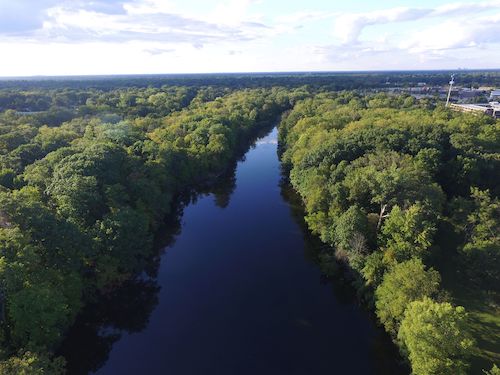Research Projects
UM-Dearborn's 120 acre Environmental Study Area is only a few feet away from classrooms and lab spaces. Its diverse habitats provide ideal study areas for university faculty and students, area high school students, and partner organizations.
Using UAV Technology to Detect Aquatic Invasive Plants

Students in the Advanced GIS class used UAVs (Unmanned Aerial Vehicles) to monitor the abundance of Eurasian Watermilfoil (EWM) in Fair Lane Lake, with the help of university faculty, and a visiting researcher.
Eurasian Watermilfoil (EWM) is an invasive submerged aquatic plant that forms a thick canopy. It blocks light penetration into the water, which reduces the diversity and abundance of native aquatic plant species in the lake. This study has shown that EWM, which is difficult to remove, is fairly widespread in Fair Lane Lake.
Thanks to the data collected by the study, the EIC staff can zero in on the aquatic vegetation in the lake and develop management plans.
Invasive Species Monitoring by Partner Organizations
The ESA is currently the study site for two invasive species monitoring efforts:
- Students and faculty from the School of Environment and Sustainability (SEAS) in Ann Arbor are using study plots to monitor the anticipated advent of Beach Leaf Disease that is approaching southeast Michigan.
- The Friends of the Rouge have been sampling Fair Lane lake for the presence of Red Swamp Crayfish.
Groundwater Monitoring
The ESA is bordered by the Rouge River and closely tied into the watershed hydrology. UM-Dearborn and the surrounding communities have seen an increase in heavy precipitation events in recent years. Heavy precipitation amounts largely drain into the Rouge River from campus both as surface water and as groundwater and subsequently affect areas downstream. Understanding the hydrology of an area is going to be increasingly important in the future.
The ESA has been equipped with 18 groundwater monitoring wells. These wells provide opportunities for UM-Dearborn students in a number of courses, as well as participants in other educational programs at the EIC, to gain first-hand experience in groundwater hydrology and water quality monitoring, and to build a network for long term monitoring of groundwater levels to better understand the subsurface hydrology from the UM-Dearborn campus downslope to the Rouge River.
Plant and Tree Surveys
The Environmental Study Area's contains different habitats that are constantly changing. Regular plant and tree surveys can help students and researchers understand ecological succession and plant community ties. The first tree survey was done in 1998 by Dr. Orin Gelderloos and laid the foundation for monitoring changes within the Study Area. A comparison with historical data from 1816 that was cataloged in 2013 by Dana Wloch helped document how much the area had changed over time. Dr. Gelderloos repeated the survey in 2020 with the help of students Griffin Bray and Kate Truitt. The plan is to continue doing regular surveys to help monitor changes in the ESA.
